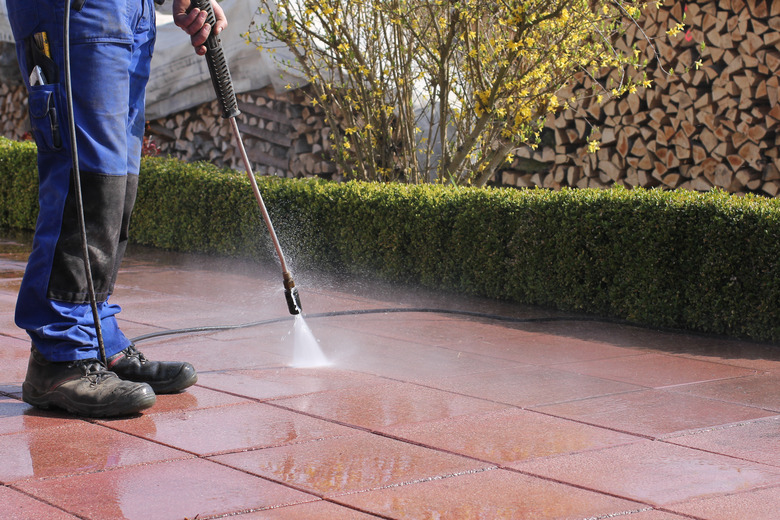
If your property is surrounded by trees, chances are your hardscapes—like driveways, patios, walkways, and decks—regularly collect sticky sap, fallen needles, seed pods, leaves, and other natural debris. Over time, these organic materials can stain, discolor, or even damage concrete, pavers, and wood surfaces if not cleaned properly.
The good news? Power washing can remove even the most stubborn tree sap and organic messes—if you know the right technique. 🌿💦
🌲 Why Tree Sap and Debris Are So Tough to Clean
Tree sap isn’t just sticky—it’s resinous, acidic, and stubborn. Combine that with decaying leaves and pollen, and you’ve got a recipe for:
- Discoloration and staining
- Slippery or hazardous surfaces
- Organic growth like algae or moss
- Clogged cracks and expansion joints
- Permanent etching or surface pitting
Ignoring sap and debris allows these issues to build up over time, especially in shaded or damp areas.
🧰 What You’ll Need
- Pressure washer (2,500–3,000 PSI ideal for hardscapes)
- 15° or 25° spray tip
- Tree sap remover, degreaser, or citrus-based cleaner
- Broom, scraper, or putty knife
- Hose and spray nozzle
- Safety glasses and gloves
- Optional: hot water pressure washer for hardened sap
Browse Amazon Here For Top Rated Power Washers And Accessories
🧼 Step-by-Step: Power Washing Sap and Tree Debris
1. Remove Loose Debris First
Before power washing:
- Use a broom or leaf blower to clear away loose leaves, seed pods, and branches
- Pick up twigs or larger items by hand
- Scrape hardened sap or gum-like patches with a plastic scraper or putty knife
Removing this top layer helps your cleaning solution and pressure washer work more effectively.
2. Apply a Sap-Safe Cleaning Solution
Tree sap isn’t water-soluble, so a good cleaner makes a huge difference.
- Use a citrus-based cleaner, degreaser, or tree sap remover
- Apply generously with a pump sprayer or directly onto the stain
- Let it sit for 5–10 minutes (but don’t let it dry)
- For extra tough sap, cover with a plastic sheet to trap moisture while it works
💡 Some homeowners swear by DIY mixes like vinegar and baking soda, but these are only mildly effective for small sap spots.
3. Choose the Right Nozzle
Attach a 15° or 25° nozzle to your pressure washer for strong but safe cleaning:
- 15° nozzle: Great for thick sap or debris lodged in joints
- 25° nozzle: Ideal for broader surfaces like patios or driveways
- Keep the wand 6–12 inches from the surface to avoid pitting
4. Power Wash with Even Passes
Spray in overlapping motions:
- Work from top to bottom or from the back of the surface toward a drain
- Focus extra attention on sap-covered or stained areas
- Use a lower angle to lift sap without damaging concrete or pavers
- Move slowly over seams or cracks where leaves and seeds collect
If the sap isn’t fully removed after one pass, reapply cleaner and repeat.
5. Rinse and Inspect
Once you’ve cleared most of the material:
- Rinse with a wide spray tip or garden hose
- Inspect for any remaining sticky spots
- Scrub with a brush if needed, then rinse again
- Allow the area to fully dry in the sun
⚠️ Avoid These Common Mistakes
- ❌ Using bleach—can react with sap or harm nearby plants
- ❌ Letting sap remover dry out before rinsing
- ❌ Spraying too close—can pit concrete or damage sealant
- ❌ Ignoring small crevices—tree debris builds up quickly there
- ❌ Using metal tools on pavers—can scratch or gouge the surface
🌿 Eco-Friendly Cleaning Tips
- Use biodegradable cleaners safe for runoff into soil
- Collect and compost leaf litter if not too soiled
- Avoid rinsing soapy water into storm drains—divert to grass or gravel
- Use a silt sock or filter if power washing near landscaping
🧠 Pro Tips for Preventing Sap and Debris Buildup
- Install shade sails or tarps over patios to limit droppings
- Trim overhanging branches annually 🌳✂️
- Apply a concrete or paver sealant to make future cleaning easier
- Schedule seasonal power washing (spring and fall are ideal)
- Keep gutters and downspouts clear to prevent water pooling and sap reactivation
🛠️ When to Call in the Pros
If you’re dealing with:
- Extremely large areas
- Sap-stained stamped concrete or decorative pavers
- Tree debris on multi-level or sloped surfaces
- Severe mold or algae in shady zones
…then hiring a professional with a hot water unit and commercial degreasers may be worth the investment.
💬 Final Thoughts
Tree sap and debris might seem like a minor nuisance—but they can quickly turn beautiful hardscapes into sticky, stained eyesores. With the right prep, cleaners, and pressure washing techniques, you can keep your patios, driveways, and walkways clean, safe, and inviting year-round.
Don’t let nature take over your outdoor spaces—reclaim them with a smart, eco-conscious pressure wash 🌲🧽✨.
Browse Amazon Here For Top Rated Power Washers And Accessories



